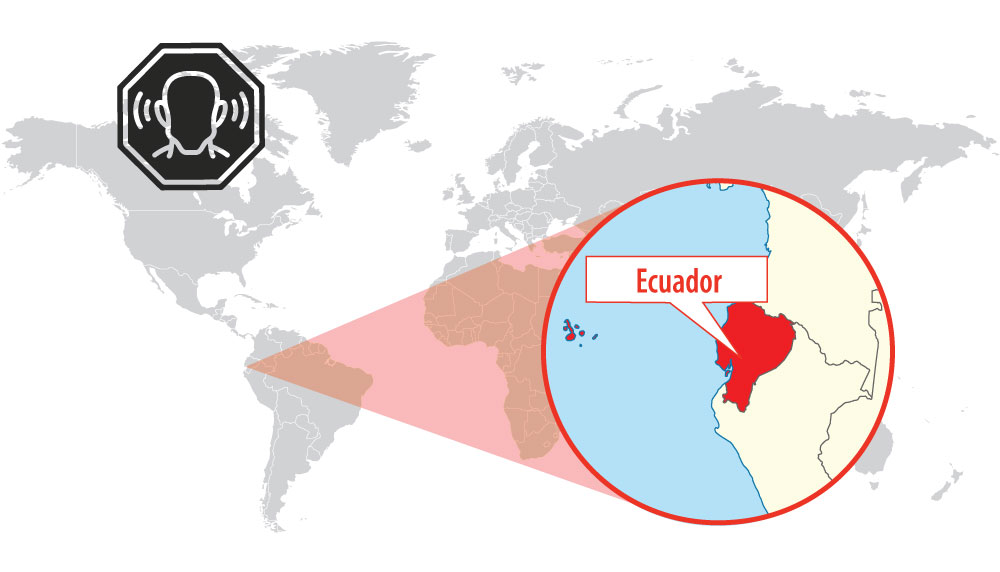Home / Casos de Éxito / Libelium ayuda a reducir la contaminación acústica en la ciudad de Cuenca (Ecuador)
La instalación de siete Plug & Sense! Smart Cities PRO con sensor de nivel de ruido permite la creación de un mapa de ruido with the highest sound pressure level.
The citizens of the Ecuadorian city had been complaining about the excessive noise in their streets for some time. Platforms such as “Cuenca without noise” han advertido repetidamente sobre la superación de los niveles legales de decibelios in some areas and demand smart solutions to make their city more livable and healthy.
Several local institutions joined forces to make it real using Libelium technology.
Ubicación de Cuenca (Ecuador)
La contaminación acústica es un problema de salud pública. La población expuesta a un nivel de ruido superior a 65 decibelios desarrolla una mayor tasa en 20% de infartos a corto plazo (Estudio de cohortes de la Agencia Federal Alemana de Medio Ambiente). Según la OMS, el la contaminación acústica excesiva perjudica gravemente la salud humana and interferes with people’s daily activities at school, at work, at home and during leisure time. It can disturb sleep, cause cardiovascular and psychophysiological effects, reduce productivity and provoke annoyance responses and changes in social behaviour.
The cost of damage caused by the noise generated by road and rail traffic was recently estimated at €40 billion only in the EU (0.4 % of the GDP).
But, how loud is too loud? The level allowed in the residential areas in Ecuador is 55 decibels from 07:00 to 21:00 and 45 decibels from 21:01 to 06:59. While on the industrial floor, the noise level maximum is 75 decibels during the day and 65 dB at night.
Esquema de la instalación
In this project, the Institute of Sectional Regime Studies of Ecuador (IERSE) of the University of Azuay, on request of the Council’s Environmental Control Commission, installed seven Libelium ¡Plug&Sense! Ciudades Inteligentes PRO nodos en diferentes puntos de la ciudad de Cuenca con los siguientes sensores:
Los puntos donde se colocaron los sensores son:
Salpicadero del sensor de nivel de ruido medido por IERSE
Existe una amplia variedad de fuentes de ruido ambiental. Industrials, traffic, street ads, alarms or works are the more common.
The University of Azuay already measured out 31 strategic points of the city once a year within the project “Evaluation of noise emissions in the city of Cuenca and noise map, with sound level meter”. To complement this information with datos en tiempo real y crear así un mapa de ruido más completo.instalaron el Sensor de nivel de ruido de Libelium to watch the behaviour of acoustic levels throughout the day.
For the election of these seven points, they were based on the data of complaints that citizens sent to the Commission of Environmental Management (Comisión de Gestión Ambiental, CGA). Those seven locations were the ones that had the highest number of sound problems.
Técnico instalando el sensor de nivel de ruido Libelium
Los miembros del IERSE realizaron pruebas comparativas del sensor de nivel de ruido Libelium con un nivel sonoro certificado y calibrado para comprobar que las mediciones suministradas tenían una gran precisión y, por tanto, podían considerarse como referencia.
La información recogida por los sensores se envía cada 10 minutos a través de 4G and stored on the University of Azuay servers. This allows continuous measurement of noise without excessive expenditure of resources. These data are public and can be viewed through their website in real-time.
“We have an efficient tool to capture important noise information and disseminate it to the general public, including decision-makers, who can track those sectors where high noise emissions are presented. This allows the intervention and better management of the behaviour of the city,” comment from IERSE.
The data compiled help to the Council of Cuenca to tomar decisiones y diseñar nuevas normativas since it has the competence of the integral management of the environment that includes prevention, control and sanction of activities that motivate it.
This plan also involves citizens as an active part of improving the quality of life in the city.
Sensor de nivel de ruido Libelium
¿Quieres recibir estas y otras noticias sobre IoT directamente en tu correo electrónico?
🔔 ¡Suscríbete a nuestro boletín y no te pierdas nada!
Aprenderá sobre IoT y cómo contribuye a hacer del mundo un lugar más sostenible y eficiente.
Este proyecto de IoT contribuye a alcanzar los siguientes Objetivos de Desarrollo Sostenible:
![]()
![]()
![]()
Más información:
Referencias: